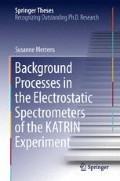Abstract
Given the complexity of the background processes described above, a highly versatile, fast and precise simulation code is required. Kassiopeia is the primary simulation package for the KATRIN experiment fulfilling all these requirements. It is written in C++, and comprised of specific modules for the creation, trajectory calculation in electro-magnetic fields and detection of particles in Si-based detectors.
Access this chapter
Tax calculation will be finalised at checkout
Purchases are for personal use only
References
F. Glück, Axisymmetric electric field calculation with zonal harmonic expansion. Prog. Electromagnet. Res. B 32, 319–350 (2011)
F. Glück, Axisymmetric magnetic field calculation with zonal harmonic expansion. Prog. Electromagnet. Res. B 32, 351–388 (2011)
W. Käfer, Investigation of the KATRIN sensitivity. PhD thesis, KIT, 2012
E. Browne, Nuclear data sheets for A = 215, 219, 223, 227, 231. Nucl. Data Sheets 93(4), 763–1061 (2001)
S.C. Wu, Nuclear data sheets for A = 216. Nucl. Data Sheets 108(5), 1057–1092 (2007)
M.S. Rapaport, F. Asaro, I. Perlman, \(K\)-shell electron shake-off accompanying alpha decay. Phys. Rev. C 11, 1740–1745 (1975)
M.S. Rapaport, F. Asaro, I. Perlman, \(M\)- and \(L\)-shell electron shake-off accompanying alpha decay. Phys. Rev. C 11, 1746–1754 (1975)
M.S. Freedman, in Ionization by Nuclear Transitions, Conference: Summer course in atomic physics, Carry-le-Rouet, France, 31 Aug 1975; Other Information: Orig. Receipt Date: 30-JUN-76, p. 18, Jan 1975
J. Baró, J. Sempau, J. Fernández-Varea, F. Salvat, PENELOPE: an algorithm for Monte Carlo simulation of the penetration and energy loss of electrons and positrons in matter. Nucl. Instrum. Methods Phys. Res., Sect. B 100(1), 31–46 (1995)
PENELOPE homepage, http://www.oecd-nea.org/tools/abstract/detail/nea-1525. Last update: 23 May 2011
S. Szucs, J.M. Delfosse, Charge Spectrum of Recoiling \(^{216}\) Po in the \(\alpha \)-Decay of \(^{220}\)Rn. Phys. Rev. Lett. 15, 163–165 (1965)
J.S. Hansen, Internal ionization during alpha decay: a new theoretical approach. Phys. Rev. A 9, 40–43 (1974)
F. Glück, Runge-Kutta method for numerical solution of differential equation system. http://fuzzy.fzk.de/bscw/bscw.cgi/d479152/rungekutta.pdf
P.W. Sharp, Numerical comparisons of some explicit Runge-Kutta pairs of orders 4 through 8. ACM Trans. Math. Softw. 17, 387–409 (1991)
J. Barrett, Embedded Runge-Kutta Steppers for KMath. http://fuzzy.fzk.de/bscw/bscw.cgi/15316
S. Filippi, J. Gräf, New Runge Kutta Nystroem formula-pairs of order 8(7), 9(8), 10(9) and 11(10) for differential equations of the form \(y^{\prime \prime } = f(x, y)\). J. Comput. Appl. Math. 14(3), 361–370 (1986)
J.C. Butcher, Numerical Methods for Ordinary Differential Equations (Wiley, Ltd., 2005)
W.H. Press, S.A. Teukolsky, W.T. Vetterling, B.P. Flannery, Numerical Recipes 3rd Edition: The Art of Scientific Computing, 3rd edn. (Cambridge University Press, New York, 2007)
J. Formaggio, RobinHood - A new Electrostatics Solver. KATRIN Collaboration meeting, Oct 2010
J. Formaggio, RobinHood, FFTMs, GPUs.. oh MY. KATRIN Collaboration meeting, Mar 2011
P. Renschler, KESS - A new Monte Carlo simulation code for low-energy electron interactions in silicon detectors. PhD thesis, KIT, 2011
F. Salvat, A. Jablonski, C.J. Powell, elsepa-Dirac partial-wave calculation of elastic scattering of electrons and positrons by atoms, positive ions and molecules. Comput. Phys. Commun. 165(2), 157–190 (2005)
D.R. Penn, Electron mean-free-path calculations using a model dielectric function. Phys. Rev. B 35, 482–486 (1987)
H. Bichsel, Straggling in thin silicon detectors. Rev. Mod. Phys. 60, 663–699 (1988)
R.C. Alig, S. Bloom, C.W. Struck, Scattering by ionization and phonon emission in semiconductors. Phys. Rev. B 22, 5565–5582 (1980)
D.T. Cromer, D. Liberman, LASL report, vol. 4403, 1970
G. Fraser, A. Abbey, A. Holland, K. McCarthy, A. Owens, A. Wells, The X-ray energy response of silicon Part A. Theory. Nucl. Instrum. Methods Phys. Res., Sect. A 350(1–2), 368–378 (1994)
J.M. Fernández-Varea, X. Llovet, F. Salvat, Cross sections for electron interactions in condensed matter. Surf. Interface Anal. 37, 824–832 (2005)
M. Hötzel, Berechnung von KATRIN Messspektren unter Einbeziehung der fensterlosen gasförmigen Tritiumquelle. Master’s thesis, KIT, 2009
W. Repko, C. Wu, Radiative corrections to the end point of the tritium \(\beta \)-decay spectrum. Phys. Rev. C28(1983), 2433 (1983)
N. Doss et al., Molecular effects in investigations of tritium molecule \(\beta \)-decay endpoint experiments. Phys. Rev. C 73(2006), 025502 (2006)
N. Doss, J. Tennyson, Excitations to the electronic continuum of \(3\rm {HeT}^{+}\) in investigations of the \({\rm T}_2\) beta-decay experiments. J. Phys. B: At. Mol. Opt. Phys 41(2008), 125701 (2008)
F. Sharipov, Numerical calculation of tritium flow through the KATRIN beam line. KATRIN, Report, 2003
F. Sharipov, “Influence of temperature variations and acoustic waves on the column density. Calculations of the velocity distribution function”. KATRIN Report, 2009
K. Eitel et al., Estimate of the KATRIN sensitivity on the neutrino mass. KATRIN, Report, 2003
Author information
Authors and Affiliations
Corresponding author
Rights and permissions
Copyright information
© 2014 Springer International Publishing Switzerland
About this chapter
Cite this chapter
Mertens, S. (2014). Monte Carlo Simulation Package. In: Background Processes in the Electrostatic Spectrometers of the KATRIN Experiment. Springer Theses. Springer, Cham. https://doi.org/10.1007/978-3-319-01177-6_4
Download citation
DOI: https://doi.org/10.1007/978-3-319-01177-6_4
Published:
Publisher Name: Springer, Cham
Print ISBN: 978-3-319-01176-9
Online ISBN: 978-3-319-01177-6
eBook Packages: Physics and AstronomyPhysics and Astronomy (R0)

